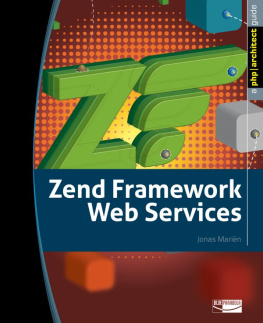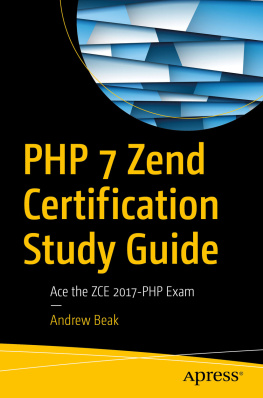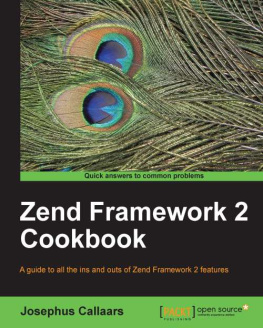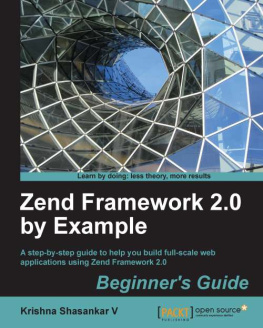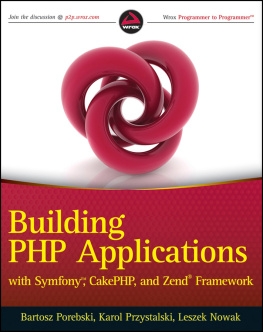Jonas Mariën - Zend Framework Web Services
Here you can read online Jonas Mariën - Zend Framework Web Services full text of the book (entire story) in english for free. Download pdf and epub, get meaning, cover and reviews about this ebook. year: 2011, publisher: Marco Tabini & Associates, Inc., genre: Computer. Description of the work, (preface) as well as reviews are available. Best literature library LitArk.com created for fans of good reading and offers a wide selection of genres:
Romance novel
Science fiction
Adventure
Detective
Science
History
Home and family
Prose
Art
Politics
Computer
Non-fiction
Religion
Business
Children
Humor
Choose a favorite category and find really read worthwhile books. Enjoy immersion in the world of imagination, feel the emotions of the characters or learn something new for yourself, make an fascinating discovery.
- Book:Zend Framework Web Services
- Author:
- Publisher:Marco Tabini & Associates, Inc.
- Genre:
- Year:2011
- Rating:3 / 5
- Favourites:Add to favourites
- Your mark:
- 60
- 1
- 2
- 3
- 4
- 5
Zend Framework Web Services: summary, description and annotation
We offer to read an annotation, description, summary or preface (depends on what the author of the book "Zend Framework Web Services" wrote himself). If you haven't found the necessary information about the book — write in the comments, we will try to find it.
Zend Framework Web Services — read online for free the complete book (whole text) full work
Below is the text of the book, divided by pages. System saving the place of the last page read, allows you to conveniently read the book "Zend Framework Web Services" online for free, without having to search again every time where you left off. Put a bookmark, and you can go to the page where you finished reading at any time.
Font size:
Interval:
Bookmark:

In this first chapter we will try to get up and running as fastas possible by showing how to set up and configure your web server,and how a basic Zend Framework application is constructed, whichwill stand us in good stead for the following chapters. This bookis conceived as a hands-on guide, exploring actual code andtechnical details where possible, so if you are interested intinkering and playing around with the code accompanying this book,you will need a working environment similar to the one described.If you already have some real life Zend Framework developmentexperience, you will be able to skim over this chapter veryquickly. If not, read it carefully and make sure you haveeverything working as it should before moving on.
Do not expect anything ground-breaking here. This book will getto real life examples as quickly as possible, and we'll keep thischapter short and clean.
Zend Framework is a PHP framework consisting of a growingcollection of components. These components can be combined into afeature-complete MVC stack. Alternatively, many of them may be usedseparately or in conjunction with other frameworks andlibraries.
Launched in 2006 by Zend Technologies, Inc - the company foundedby the two original authors of the Zend Engine - Zend Frameworkquickly gained traction to become one of the better-known PHPframeworks. At the time of writing, it has been adopted by a largenumber of companies and considerable parts of the community.
Some consider Zend Framework, and frameworks in general, to bebloated and prefer their code custom-crafted for each task. Yetwhenever development teams grow in size and customer demands groweven faster, the need for a clear application structure and codereusability becomes more urgent. This is where frameworks come intoplay, along with coding guidelines, unit testing, automatic APIdocumentation and Continuous Integration systems. All of thesetechniques and their rise in popularity are part of a tendency inthe PHP world towards more mature development practices, moremature teams and enterprise readiness.
Growing numbers of professional PHP developers use thesetechniques, taking their code to the next level using frameworkslike Zend Framework, Symfony, Solar, Kohana, CakePHP and many, manyothers. Some of these frameworks are here to stay, while some willeventually disappear, and yet others will grow to an even moredominant position. Zend Framework, given its pedigree and thequality of the code, is most likely here to stay.
All good and well, but is this the only reason that ZendFramework is chosen for a book on web services? Not at all.Firstly, the components provided by the framework for web servicecreation are mature and well-designed. They offer good integrationwith the rest of the framework and are comprehensively documented.Secondly, the entire code is unit-tested and peer-reviewed.Thirdly, there is no licensing fuss around Zend Framework: the codeis created from scratch and all contributors must sign an agreementwhich clearly regulates the licensing. Finally, I just like it. Ihad to pick one of the available frameworks for this book and ZendFramework seemed an obvious choice, at least to me.
For more information on Zend Framework, such as a detailedhistory and its positioning compared to other frameworks andsolutions, there are plenty of online resources available. Many ofthese are centered around the Zend Framework website. Among otherthings, you will find the Zend Framework reference manual there, aswell as the option to file a bug report, and to browse theSubversion repositories and the development wiki.
If you are a Zend Framework novice, going through thequick-start tutorial will be of great help and will introduce youto some key concepts in a very steady pace and comprehensiveway.
Also, do note that a major new version of Zend Framework will beavailable in the coming months. On the website accompanying thisbook, the example code will be updated for this new version, alongwith some detailed notes where necessary. Appendix C has anoverview of the potential impact of version 2.0 on our code.
For your environment to be usable, you will need a web serverand database server. I chose Apache and MySQL for this, since theyare widely-used and well-known to most PHP developers. As for theoperating system, I am an Ubuntu and Debian Linux user myself, buteverything which follows should be possible on RPM-baseddistributions, on Windows, Mac OSX or even FreeBSD. Appendix A hassome pointers on installing all the necessary tools on these otherplatforms.
Installation of Apache, PHP and accompanying services like MySQLcan be done using apt-get on Debian systems anddistributions derived from it:
- apt-get install apache2 libapache2-mod-php5 php5php5-common php5-cli php5-mysql php5-xmlrpc mysql-client-5.1mysql-common mysql-server
If you are prompted for input on some configuration choices,just accept the defaults, as they should be sufficient for now. Youshould also enable the Apache mod_rewrite module,using the command a2enmod rewrite.
Throughout this book the latest version of Zend Frameworkavailable at the time of writing will be used, which is currentlyversion 1.10.2. Zend provides a choice of the full or minimalversions, with the latter containing only the library's standardcomponents, and this version will serve us well. Download theframework from the ZendFramework website and unpack:
- mkdir -p /web/zfws/ && cd /web/zfws
- wgethttp://framework.zend.com/releases/ZendFramework-1.10.2/ZendFramework-1.10.2-minimal.tar.gz
- tar zxvf ZendFramework-1.10.2-minimal.tar.gz
- mv ZendFramework-1.10.2-minimal/library .
- mv ZendFramework-1.10.2-minimal/bin .
- rm -rf ZendFramework-1.10.2-minimal
The library/ directory contains all of the ZendFramework components. The bin/ directory contains theZend_Tool scripts for bootstrapping our project code.
Now, for ease of use, you could let the user and group runningApache own the entire source tree. On Debian Linux, you could dosomething like this:
- chown -R www-data.www-data /web/zfws
- chmod -R g+w /web/zfws
This makes the tree writable for the www-datagroup. You can add your own user to the www-data groupby adding www-data to your group memberships. Replacejonas with your own username in the following command:
- usermod -a -G www-data jonas
Do note that the above is not considered good practice for aproduction environment, since an Apache user should not be able towrite files all over the place. More on this and security ingeneral can be found in Chapter 11.
Now let's define a virtual host for Apache, so that our webserver knows where to find the files for our site. The contents ofthe file you should create in/etc/apache2/sites-available/zfws are as follows:
- ServerAdmin you@example.com
- ServerName zfws
- DocumentRoot /web/zfws/public
- AllowOverride None
- Options IndexesFollowSymLinks MultiViews
- AllowOverride All
- Order allow,deny
- allow from all
- setenv APPLICATION_ENVdevelopment
- LogLevel warn
- ErrorLog/var/log/apache2/zfws-error.log
Font size:
Interval:
Bookmark:
Similar books «Zend Framework Web Services»
Look at similar books to Zend Framework Web Services. We have selected literature similar in name and meaning in the hope of providing readers with more options to find new, interesting, not yet read works.
Discussion, reviews of the book Zend Framework Web Services and just readers' own opinions. Leave your comments, write what you think about the work, its meaning or the main characters. Specify what exactly you liked and what you didn't like, and why you think so.

